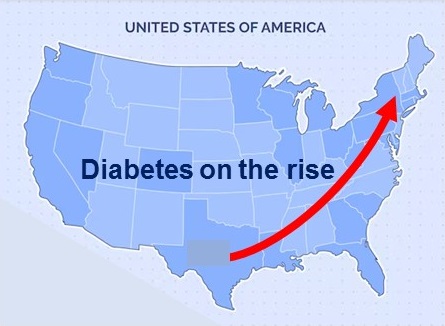By: Adebowale Bello. B.Tech Microbiology. Freelance Health Writer.

Diabates is rising in the US with an increase of nearly 19 percent between 2012 - 2022. Any lessons for Africa?
Type 2 diabetes has become a global health concern. Factors like educational background, income, changing lifestyles and rapid urban development have contributed immensely to the steady rise in diabetes.
Recent study has shed light on the growing burden of this disease in the US, discussing the role of several factors that have contributed to its increasing prevalence. In this blog, we’ll look at the key takeaways from this research and discuss lessons that may apply to Africa.
Diabetes is a medical condition where the body either doesn’t produce enough insulin (Type 1 diabetes) or cannot effectively use the insulin it makes (Type 2 diabetes). This leads to high blood sugar levels, which may result in serious health complications, such as heart disease, kidney failure and vision problems.
According to the World Health Organization, 422 million persons live with diabetes and there are 1.5 million deaths annually. Even with these concerning figures, diabetes is on an alarming rise.
The study published in August 2024 analyzed diabetes data from over 5 million people between 2012 and 2022, and also obtained an additional data sample of 400,000 persons.
Figures from the Centers for Disease Control and Prevention (CDC) show that 38.4 million or 1 in every 10 Americans have diabetes, still, the study found that the overall prevalence of diabetes increased by nearly 19% in the 10-year period under review.
Here are some findings from the study:
The rise of type 2 diabetes in Africa mirrors global trends but the continent faces unique challenges that require targeted solutions.
While the lifestyle factors contributing to diabetes in the US may differ somewhat from those in African countries, many of the same risk factors exist.
For example, in many African countries, people who live in the cities are more likely to be less active because of high dependence on motor vehicles for mobility rather than walking or cycling. They are also likely to drink, smoke and consume diets that are high in processed foods, thereby increasing their risk of obesity and diabetes. Those in the rural areas are more likely to be physically active but face economic challenges that stir their dietary intake towards high carbohydrate content and limit access to preventive and promotive healthcare. Both factors increase the odds for type 2 diabetes.
By promoting healthier lifestyles, addressing economic challenges and improving healthcare access, Africa can reduce the burden of this chronic disease. With timely intervention, public awareness and investment in healthcare infrastructure, the continent can prevent diabetes from becoming an overwhelming public health crisis.
Governments and health organizations in Africa need to focus on expanding access to healthcare, particularly in underserved communities. Mobile health clinics and training programs for local health workers can improve diabetes prevention and management in rural areas.
African governments must also invest in education and create policies and infrastructure that make healthy food more accessible. Public health campaigns can also play a vital role in educating people about the importance of a balanced diet, regular exercise and routine health check-ups to catch early signs of diabetes.
Source: Neupane S, Florkowski WJ, Dhakal U, Dhakal C. Regional disparities in type 2 diabetes prevalence and associated risk factors in the United States. Diabetes Obes Metab. 2024; 1-7. doi:10.1111/dom.15797. Available from here.
Related:
Type 1 Diabetes Mellitus: An Explainer for Africans
Type 2 Diabetes: What Africans Need to Know
Management of Type Two Diabetes in Nigeria
Published: September 9, 2024
© 2024. Datelinehealth Africa Inc. All rights reserved.
Permission is given to copy, use and share content for non-commercial purposes without alteration or modification and subject to source attribution.
DATELINEHEALTH AFRICA INC., is a digital publisher for informational and educational purposes and does not offer personal medical care and advice. If you have a medical problem needing routine or emergency attention, call your doctor or local emergency services immediately, or visit the nearest emergency room or the nearest hospital. You should consult your professional healthcare provider before starting any nutrition, diet, exercise, fitness, medical or wellness program mentioned or referenced in the DatelinehealthAfrica website. Click here for more disclaimer notice.